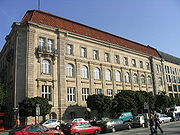
German Academy of Sciences Berlin
Encyclopedia

The academy was founded in 1946 by the Soviet Military Administration in Germany to continue the long tradition of the Prussian Academy of Sciences
Prussian Academy of Sciences
The Prussian Academy of Sciences was an academy established in Berlin on 11 July 1700, four years after the Akademie der Künste or "Arts Academy", to which "Berlin Academy" may also refer.-Origins:...
and the Brandenburg Society of Sciences, which had been founded in 1700 by Gottfried Wilhelm Leibniz. To facilitate publishing, the Akademie Verlag
Akademie Verlag
Akademie Verlag is a German scientific and academic publishing company, originally founded in 1946 in the Soviet-occupied Eastern part of divided Berlin to facilitate the publication of works by and for the German Academy of Sciences Berlin....
was founded also in 1946. The 250th anniversary in 1950 was already boycotted by West Germans due to the influence of the socialist East German authorities, which mainly had East Germans elected to the academy in the decades to follow. It became the most important academy
Academy
An academy is an institution of higher learning, research, or honorary membership.The name traces back to Plato's school of philosophy, founded approximately 385 BC at Akademia, a sanctuary of Athena, the goddess of wisdom and skill, north of Athens, Greece. In the western world academia is the...
in the German Democratic Republic, and was accordingly renamed 'Academy of Sciences of the GDR' (Akademie der Wissenschaften der DDR) in 1972, once the division of Germany was accepted as the state of affairs. In the 1980s, the AdW itself had over 200 members, including two dozen West Germans. It coordinated research at 59 institutes that employed 22,000 persons. Following the fall of the Berlin wall, academy members called for a reform of the academy, rejecting the leading role of the Socialist Unity Party of Germany
Socialist Unity Party of Germany
The Socialist Unity Party of Germany was the governing party of the German Democratic Republic from its formation on 7 October 1949 until the elections of March 1990. The SED was a communist political party with a Marxist-Leninist ideology...
.
On 27 June 1990, the new GDR government reorganized the academy, turning it into a public organisation. Until late 1991, the former AdW institutes were separated from the academy, evaluated, and either dissolved or assigned to different organisations, mainly the Gottfried Wilhelm Leibniz Scientific Community. As the states of Berlin and Brandenburg considered a continuation of the academy as improper due to its role in the GDR, the academy, which had about 400 members, was disbanded and the Berlin-Brandenburgische Akademie der Wissenschaften ("Berlin-Brandenburg Academy of Sciences and Humanities") was founded in 1993.
On 15 April 1993, 60 of the former academy members created the private organisation Leibniz-Sozietät which claims to represent 300 years of continuous academic tradition. It has now over 300 members, of which most were elected since 1994.
External links
- http://www.leibniz-sozietaet.de

